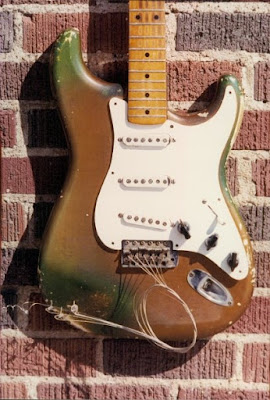Charlie Christian
Charles Henry Christian was born in Bonham Texas on July 29 1916. The Christians moved to Oklahoma City Oklahoma while Charlie was still a baby. He had two brother Edward and Clarence JR, his father was Clarence SR. Charlie's father went blind from fever and to support the family he and his children would preform on the street, at first charlie would just dance but when his father died when charlie was 12 he inherited his fathers acoustic guitar.
He attended the Douglass School in Oklahoma City. His music teacher was Zelia N. Breaux, at first Charles wanted to learn Tenor Saxophone but Zelia insisted he play trumpet. Christian believed playing the trumpet would disfigure his lip so he quit and pursued a baseball career, he was quite good at it.
With Benny Goodman 1940
In 1939, Christian auditioned for John Hammond, who recommended him to bandleader Benny Goodman, Goodman was one of the first white bandleaders to feature black musicians in his live band, That was very uncommon in the 1930s. Goodman hired Christian to play with the newly formed Goodman Sextet in 1939. Goodman was at first not interested in hiring Christian because the electric guitar was not a popular instrument at the time, but Goodman was so impressed with Christian's ability he hired him on the spot. Charlie went from making a dollar fifty a week the 350.00 a week overnight.
Seven Come Eleven
Live in 1941 at Minton's Playhouse the whole set
Solo Fight
Gibson ES 150
ES-150 guitar is generally recognized as the world's first commercially successful Spanish-style Electric Guitar. The ES stands for Electric Spanish, and it was the designated 150 because that was the price. The price also included an Amp the EH-150 and a cable. The guitar had a mahogany neck solid spruce top and maple back and sides, and had a 24 and 3.4 scale length.
The amp had an protective latch on case to protect the speaker while traveling.
Back of the amp
This Video show what the amp looks like on the inside
An Advertisement from the early 40s the ES-150 had changed slightly and the more expensive ES-250 was in production
Seymour Duncan Explaining the charlie Christian pickup
Guitar Sheet Music
In late 1939 Charlie contracted Tuberculosis and was hospitalized in early 1940 and went back to Oklahoma to visit family because goodman was having back trouble and couldn't tour for a few months. March 2, 1942. He was 25 years old. He was buried in an unmarked grave in Bonham Texas



















































.jpg)











